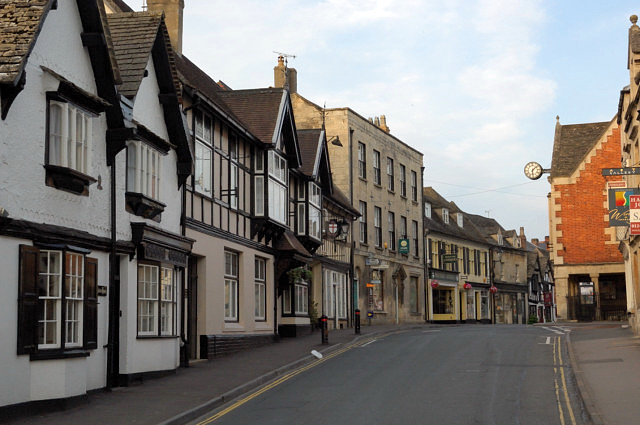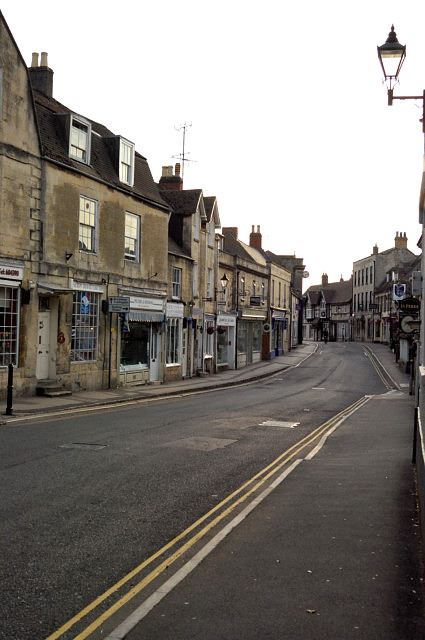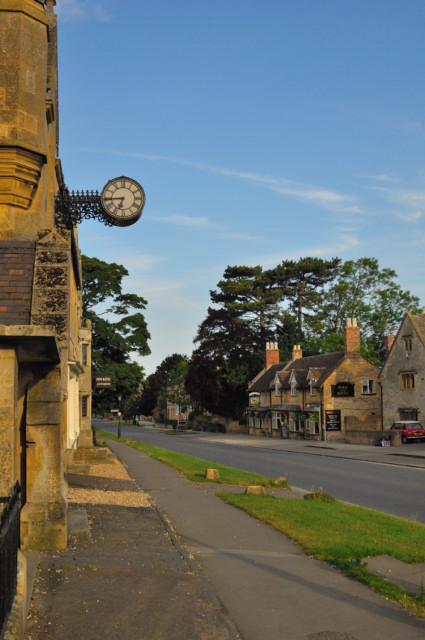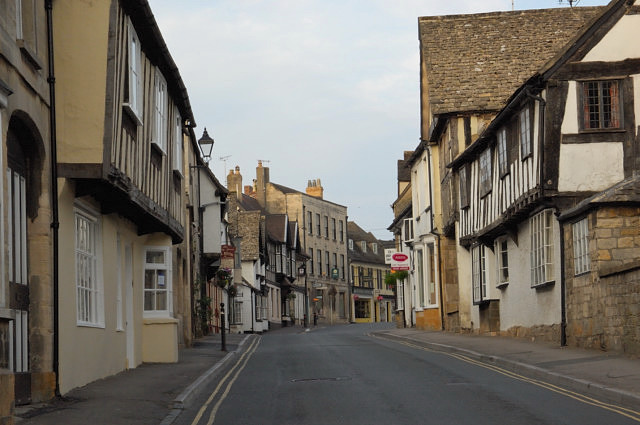Article
Traffic Free Photography
Have you wondered how some photographers get
scenes of market towns with no traffic, London streets when no traffic or people
are present, photos of empty motorways, or photos at attractions with no crowds.
 
| You might think that each has its own story,
for example motorway closed for some reason leaves it with no traffic, or
special permission to enter an attraction when its closed allows you to get
photos with no people, or perhaps you think the photographer is a retired police
officer who got his mates to close a road or hold up the traffic. In most cases
none of this occurred, its just a matter of the photographer having the knowledge,
skills and taking the actions required to produce the photo he or she required. There are a range of approaches that can
produce the results required:-
Not all are practical in all situations, for example
you could not hold up the traffic on a motorway, but to have someone
stall a car to plan in a towns one way system could give you a minute of traffic
free street.
You can apply these techniques to panoramas and
3D photography
 as well as your normal photographs. It just needs
a little thought and perhaps some experimenting.
as well as your normal photographs. It just needs
a little thought and perhaps some experimenting.
|
 |
Planning to take photos at a specific time
Early Morning - During the summer, June
and July are best, an early start allows you to get out and take photos before
most others are up and about. This is a particularly good approach to
photographing market towns, and picturesque village locations, at this time of
day there is only the occasional car and usually no pedestrians out and about.
You will also find at this time of day a lot more wildlife is about, including
birds of prey flying down roads looking for road kill carcases. This does work
for towns but not as well, as many towns have a night life and in the early
morning the streets are a mess with a lot of rubbish everywhere, then you have
the street cleaners out and about in your shots. You may still find taking the
photos in towns early and then editing out all the rubbish is a practical if
time consuming proposition. Some years ago I visited a number of the fruit
and vegetable markets in the London area, so it was a very early start. At this time
of day you had wide empty multi lane roads in most of London, so this approach
may work in many places.
Weekends - Central London particularly
is a ghost town at weekends, particularly before tourists are about. Business
estates, and many commercial rather than shopping districts can be very quiet.
Residential areas however can have loads of parked up traffic.
Others - There are times when roads are
shut, perhaps pipes being laid or construction work. There may also be regular
obstructions such as bin collections in narrow streets that create traffic free
times that can be expected. Most councils have their bin collections by street
on their websites. A builders skip being delivered or collected, cars being
delivered or even a large vehicle backing into a supermarket can cause a few
minutes of traffic free road, and in many cases you can predict when it will
occur. Pedestrian crossings and traffic lights also cause traffic to flow in
pulses with times when there are none.
Causing an obstruction
In a friendly village this is a very practical
proposition, if you are holding things up for few minutes at most you are
unlikely to get objections.
Similarly most are understanding of the person
who stalls their car, and has to then get it going again or takes few back and
forths to get into a parking place. Even stopping to ask directions can hold
things up a minute or two. The objective if you choose this option is to
do things in a way that creates no objection, and causes no one a major delay.
Arranging a community project
Let us suppose you have a picturesque area and
you want to take a photo of a particular street, but there are never times when
traffic is not present, perhaps its a residential area. This occurs a lot in
country towns and villages and yet postcard producers and many others get
traffic free photos. The solution to this is to have a local project, you
decide a convenient time for you and the residents when you request that
everyone moves their car, and they like you can get photographs of their street
with no traffic. You need then to produce a handout explaining this, dropping in
a copy several days before and a reminder the day before. It may also be worth
putting a copy of each mailing on all the cars as some people may not live in
the street but elsewhere nearby. As it benefits everyone and few will want to be
the odd one out who don't comply, most will have moved their cars, and you will
be left with knocking on the doors of a few people to ask them to move their
cars. You will probably find other local residents are out with their cameras
and only too pleased to help you knock up those who have not moved their cars.
Before planning this check out the area, the light at the time of day you
propose to take photos and chat to a few local people to make sure there are no
unexpected problems. Avoid the day the bins are collected or they will all be in
your shot. Sunday mornings early but not too early are a good time, as you are
not likely to have a lot of others who are trying to park in the area you have
cleared. Don't ever offer to pay people to move or not park where you don't want
them to or the news will get around and all their relatives arrive with their
cars as well.
|

| All the pictures on
this page were taken early morning, you can see the clock in the
picture above is showing 6.45am and in clock in the top image is at
6.10am. The pictures except for the one immediately above are taken
what is normally the very busy but picturesque town of Winchcombe,
Gloucestershire in the Cotswolds. The picture above was taken at
Broadway a major tourist attraction usually packed by people and
traffic. |
 All pictures on this page
All pictures on this page |
Use of filters
If you have a time exposure that is very long
running into minutes, moving items do not show. The problem is that you would
have an over exposed shot, unless you choose the middle of a dark night, to
overcome this problem, you put in effect very strong sunglasses on your camera.
The filter used is a Neutral density filter with a high value. You can stack up
neutral density filters as long as the mounts don't get into the corners of your
shots, so you don't necessarily need to go and spend a fortune. We have an
article on
ND filters  that looks at the values and effects on exposure. You can get
ND filters with a
filter factor ND400, or NDx being darker still. I use an ND64, and some times
combine this with an ND2, 4 or 8 which are far more common everyday values.
When you combine them you just multiply them so a ND64 and ND8 = ND512. that looks at the values and effects on exposure. You can get
ND filters with a
filter factor ND400, or NDx being darker still. I use an ND64, and some times
combine this with an ND2, 4 or 8 which are far more common everyday values.
When you combine them you just multiply them so a ND64 and ND8 = ND512.
You can extend the
Exposure
 by using the lowest
ISO,
by using the lowest
ISO,
 perhaps ISO 100 and smallest
Aperture
perhaps ISO 100 and smallest
Aperture
 for your lens, perhaps F32. With wide angle lenses just do some tests to make sure
that with a very small aperture the filters are not coming into focus, or they
will have to be super clean, not that you would use a dirty filter at any time.
for your lens, perhaps F32. With wide angle lenses just do some tests to make sure
that with a very small aperture the filters are not coming into focus, or they
will have to be super clean, not that you would use a dirty filter at any time.
You won't be able to see through a very high
value ND combination or set your camera exposure metre with this on, so you will
need a tripod and a little thought on setting the exposure manually, although
many do it by trial and error, staring with a shorter time and doubling the
exposure until they have the results they require. Once you have done this you
can see the difference from the cameras normal exposure and the exposure with
the combination of filters in use. If you, like me, would rather be in control and
work it out then think in terms of EV, see
EV and the EV
Table  and we have an
EV Guide,
and we have an
EV Guide,
 3 fold handout
which you can download, print and use, making this process easier. 3 fold handout
which you can download, print and use, making this process easier.
With a high value ND filter you can take photos
of motorways with no traffic, you can take photos at any time of tourist
attractions with no tourists, all you need to do is to make sure that everything
is moving, and take few photos just in case.
Multiple images
Let us take an example of a tourist attraction
and we have people walking through the area of interest, now each person is in a
place only for a part of the time. If we put our camera on a tripod and take a
number of photos, and then in something like Photoshop we stack these images up
as a number of layers, all we have to do is in effect go down the pack rubbing out
sections of the top image where there is a person, to show the area underneath on
the next photo in the stack, and so on until we have no people or other items we
don't want. If we still have a problem we can just reorder the stack and start
again, in a different combination will probably work.
In Photoshop in practice you can use masks so
you don't actually rub out the photos but select the areas that you want to
appear to be transparent, as you can add or take away from the masks you can
finely adjust them if the need arises.
You need to take the images while the lighting
and shadows are the same, so it won't work well if you take a photo an
hour, to allow parked cars to move about, unless you do it on an overcast day.
Its best, if you can, to use manual settings and
set a
white balance
 as
you would with a panorama, so when parts of different photos come together they
have the same exposure and colour balance. as
you would with a panorama, so when parts of different photos come together they
have the same exposure and colour balance.
If it's just a single person or group at a
time walking through your shot you may only need two photos in your stack. The
larger the flow of people the larger the number of photos you will need to have
every area clear of people in at least one photo. I suggest you always take too
many images just in case.
Editing
The clone tool allows you, within most editing
programs, to copy an area from part of the photo into another area, and is
useful for removing rubbish, and maybe other items you don't want. Its
time consuming and patterned items like walls can take a lot of time.
Combining a number of these ideas together
In some situations you may chose to combine
these ideas together for example selecting a method that has a lower flow,
like early morning or other time and then taking a stack of images. With
motorway traffic using ND filters at a time of day when there is a lower and
faster flow works better than in the rush hour when traffic can be nearly
parked.
  |